
After releasing their high-end Ryzen 7 and mid-range Ryzen 5 CPUs onto the market, it’s now time for AMD to fight the good CPU fight at the entry-level range of things where Intel’s i3 and G4000 series. Before Ryzen 3, AMD’s offerings in the entry-level market were their FX series, specifically the aging FX 6300, and their Kaveri APUs. Well, let’s get on with the review with one of the Ryzen 3 chips, the 1300X.
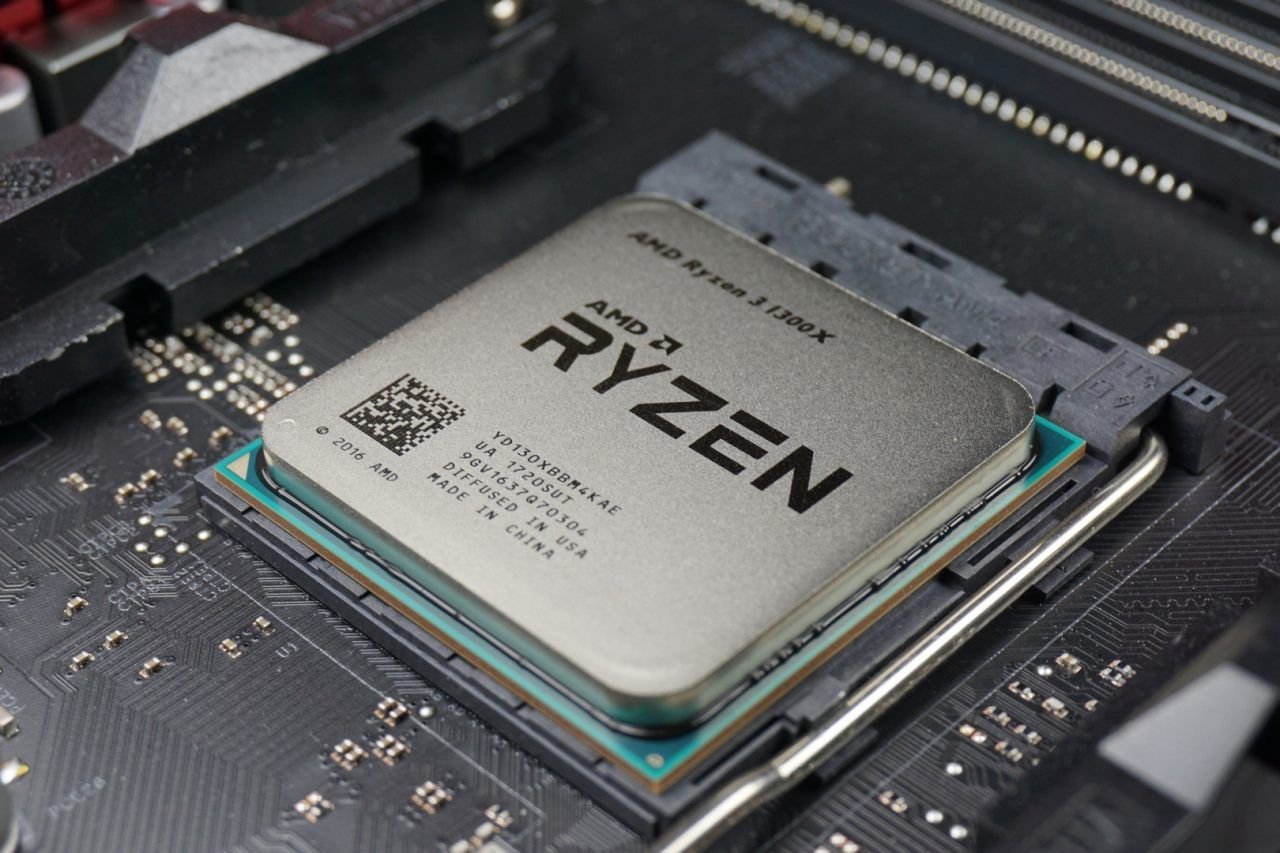
Before we get to it though, check out the specifications of AMD’s current Ryzen range:
| Ryzen | ||||||||
| Product Line | Model | Cores/Threads | Base Clock | Boost Clock | L3 Cache | TDP | Included Cooler | SRP (with VAT) |
| Ryzen 7 | 1800X | 8/16 | 3.6GHz | 4.0GHz | 16MB | 95W | N/A | PhP 27,000 |
| Ryzen 7 | 1700X | 8/16 | 3.4GHz | 3.8GHz | 16MB | 95W | N/A | PhP 21,000 |
| Ryzen 7 | 1700 | 8/16 | 3.0GHz | 3.7GHz | 16MB | 65W | Wraith Spire | PhP 17,500 |
| Ryzen 5 | 1600X | 6/12 | 3.6GHz | 4.0GHz | 16MB | 95W | N/A | PhP 13,800 |
| Ryzen 5 | 1600 | 6/12 | 3.2GHz | 3.6GHz | 16MB | 65W | Wraith Spire | PhP 11,995 |
| Ryzen 5 | 1500X | 4/8 | 3.5GHz | 3.7GHz | 16MB | 65W | Wraith Spire | PhP 10,500 |
| Ryzen 5 | 1400 | 4/8 | 3.2GHz | 3.4GHz | 8MB | 65W | Wraith Stealth | PhP 9,250 |
| Ryzen 3 | 1300X | 4/4 | 3.4GHz | 3.7GHz | 8MB | 65W | Wraith Stealth | PhP 7,250 |
| Ryzen 3 | 1200 | 4/4 | 3.1GHz | 3.4GHz | 8MB | 65W | Wraith Stealth | PhP 6,000 |
The AMD Zen Architecture

Courtesy of AMD.
AMD’s Ryzen processors are the first batch of CPUs to use their new Zen architecture. This new architecture boasts a massive leap in performance compared to the Excavator microarchitecture. Not only did AMD gain a huge 52% increase in instructions per cycle (IPC), they’ve also put in tons of work in the technology behind the Zen architecture.

Courtesy of AMD.
AMD was able to gain a 52% increase in IPS due to the design of Zen. Aside from the 1.75x larger instruction scheduler window and 1.5x better issue width and resources, Zen also uses a “neural network” to better understand an application. The AI, as AMD would like to put it, prepares CPU instructions so the processor is ready to take on a new workload.
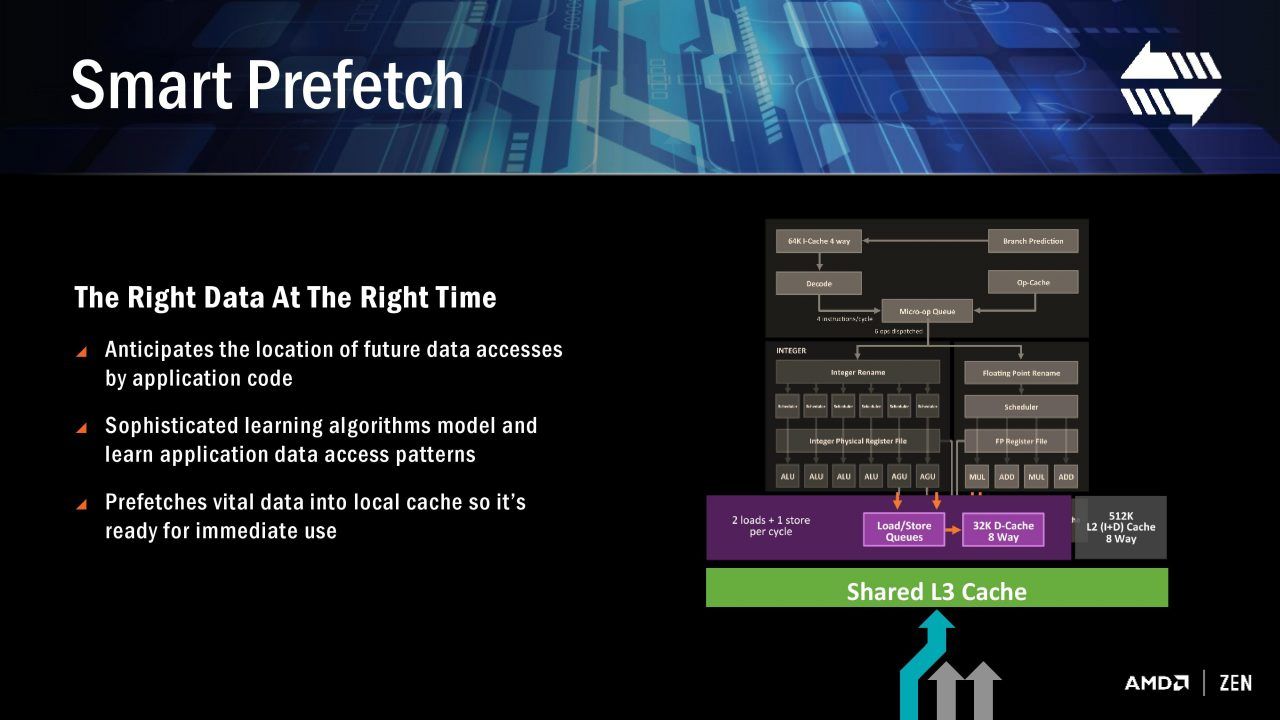
Courtesy of AMD.
This is further helped by the employment of Smart Pretech that anticipates and pre-loads data into cache in the CPU for faster and more responsive computing. The cache is also established at a lower level near the core to get up to 5x more cache bandwidth into a core. This allows Zen to essentially bypass L2 and L3 cache when using routinely accessed micro-operations.
The CPU Complex

Courtesy of AMD.
At the heart of every Ryzen processor is the CPU Complex (CCX). A CCX is a 4-core, 8-thread module, which has 64K of L1 I-cache, 64K L1 D-cache, 512KB dedicated L2 cache per core, and a shared 8MB cache across all cores in the CCX.
Since the CCX is the brain of a Ryzen processor (well, brains since there are more than one CCXes in one CPU), AMD has developed what the call an Infinity Fabric to allow the CCXes to communicate with each other to do meaningful work. This fabric allows the Ryzen to be scalable across all markets such as HPC, servers, HEDT to entry-level computing.

Courtesy of AMD.
The Infinity fabric also acts as a communication bus to allow the exchange of data between CCXes, system memory (RAM), and other devices such as PCIe bus, I/O, and storage. The only downfall of the Infinity Fabric is that it uses RAM to interconnect everything. Thus, you would need fast RAM with low timings for optimal processing performance.
Ryzen processors may also use Simultaneous Multi-threading (SMT). If you’re unfamiliar with SMT, it is essentially AMD’s version of Intel’s Hyper-threading, which allows applications to use multiple independent threads for faster execution. In AMD’s current Ryzen processors, the Ryzen 7 CPUs use a 4+4 setup with SMT for a total of 8-cores and 16-threads of processing power. Meanwhile, 6-core parts such as the Ryzen 5 range (1600X and 1600) use a 3+3 configuration with SMT for a total of 6-cores and 12-threads. In this case, the Ryzen 3 1300X uses a 2+2 setup, much like the Ryzen 5 1500X and 1400, however, the 1300X (and 1200) comes with SMT disabled. So, it’s basically setup like Intel’s i5 range, 4-cores and 4-threads.
AMD SenseMI

Courtesy of AMD.
With the help of the Infinity Fabric, AMD’s SenseMI allows its grid of sensors to push the performance of the CPU. According to AMD, their sensors are accurate to 1mA, 1mV, and 1°C, and are polled by the system 1000 times per second. These metrics are then read by the Infinity Fabric to make on-the-fly adjustments to the CPU on the current operating conditions.
Pure Power

Courtesy of AMD.
Every silicon is unique. It might need more power to achieve higher clocks or less power to get to the same clocks. AMD’s Pure Power reads data from the current usage of the CPU and uses that data to streamline power consumption while the CPU is working.
Precision Boost
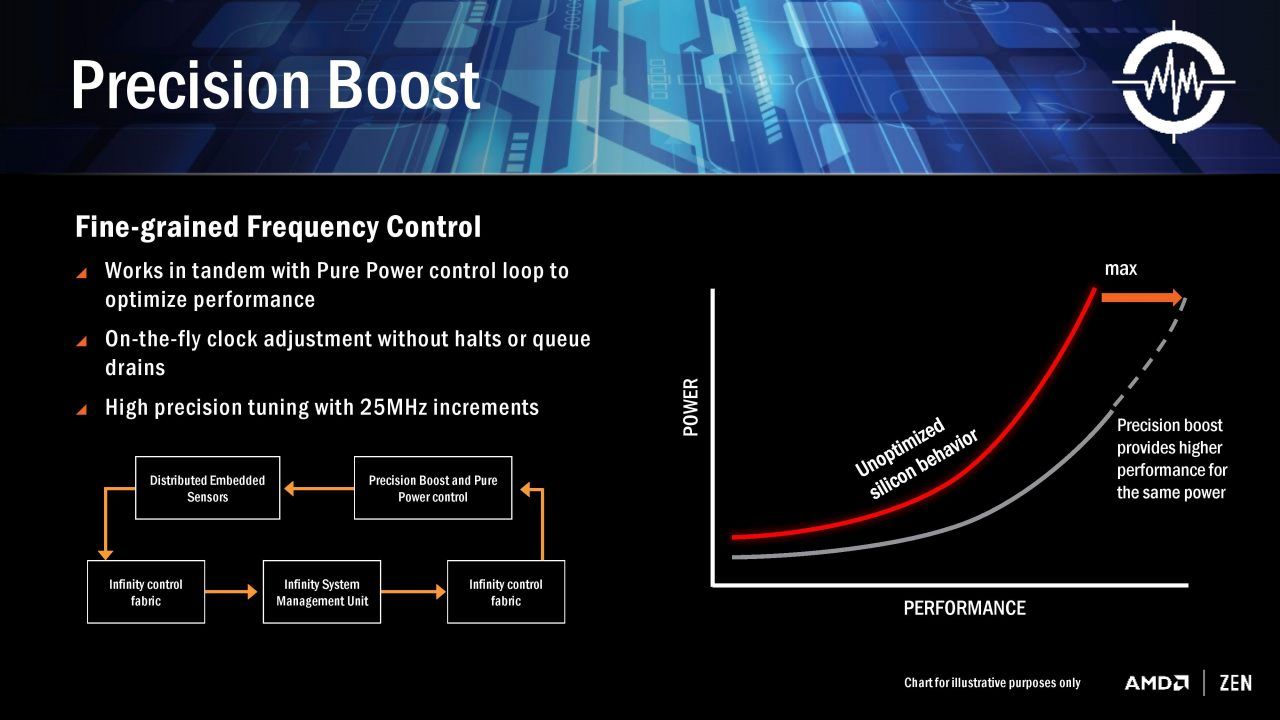
Courtesy of AMD.
Precision Boost gathers data from the Infinity Fabric and adjusts the CPU’s clock speeds in 25 steps. This allows Ryzen and other Zen-based processors in the future to finely tune their frequency target compared to Intel and older AMD processors which only have control over 100MHz steps.
Extended Frequency Range

Courtesy of AMD.
With the help from all the telemetry gathered, AMD’s Extended Frequency Range (XFR) allows the CPU to overclock itself. Since not everyone is willing or know how to overclock, this is a better solution to get more from your CPU without manually overclocking your system. XFR, however, would need a more premium cooling solution to get the best out of your CPU.
The new AM4 socket
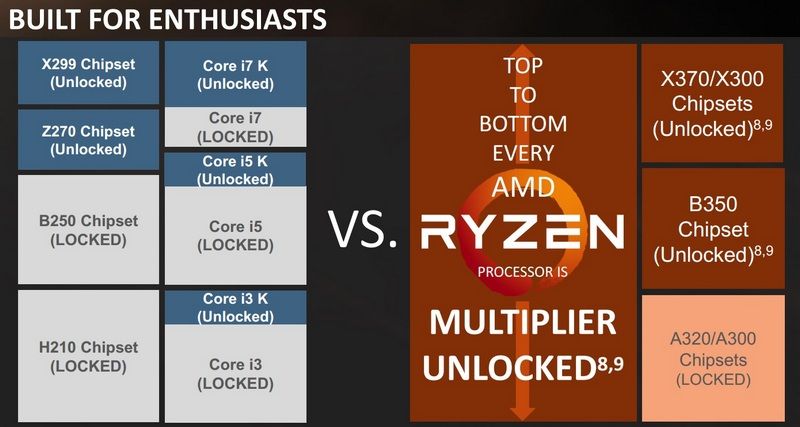
Courtesy of AMD.
Meant to house their new Ryzen CPUs, the AM4 platform was co-developed by ASMedia. It currently consists of five chipsets that’s meant to be paired with the new 1331 socket. This new socket still uses PGA (Pin Grid Array) instead of LGA (Land Grid Array), which means that the pins are still connected to the CPU instead of the motherboard which Intel has been using for many years now.
Aside from Ryzen, AMD’s soon-to-be-released Raven Ridge APUs can also be used with the AM4 chipset, which is why we’re seeing display ports on some AMD motherboards even if the current Ryzen CPUs doesn’t have any on-die GPUs
As expected, the brand new chipset supports high-end features such as NVMe PCIe 3.0 x4, SATA III, SATA Express, Dual Channel DDR4, native USB 3.1 Gen2, and more. Check out AMD’s table below to see how each chipset compares with one another:

Courtesy of AMD.
Apart from high-end features, the AM4 platform also uses a different heatsink mounting system compared to the old AM3 platform. The bolt-through mounting system has been widened to house the 1331 socket. Mounting clip-style coolers on the motherboard, however, should not pose any problems. Coolers with their own mounting system might have problems. You might need to purchase another cooler or contact your heatsink brand to check if they can send you an AM4-compatible mount
Now that’s over, let’s get on with the review of the Ryzen 3 1300X.

As an entry-level part, you can’t really expect much from the Ryzen 3 1300X. It comes with a Base Clock of 3.5GHz with a Turbo of 3.7GHz. Knowing Ryzen platforms, you can probably get up to 4.0GHz with the 1300X easily. Anything beyond that, however, is purely luck in the silicon lottery. The downside of the 1300X is its lack of SMT. This means that even if it’s essentially the same inside like its Ryzen 7 and 5 brothers, it would be behind them in performance when it comes to multi-threading tasks.
Priced at PhP 7,250, the 1300X is poised to do battle with Intel’s own i3 series and AMD’s older FX series processors. Since it doesn’t have an on-die GPU like Kaveri APUs, AMD has made a smart decision of leaving the APU market alone for now until Raven Ridge APUs come in the future.
System and Overclocking
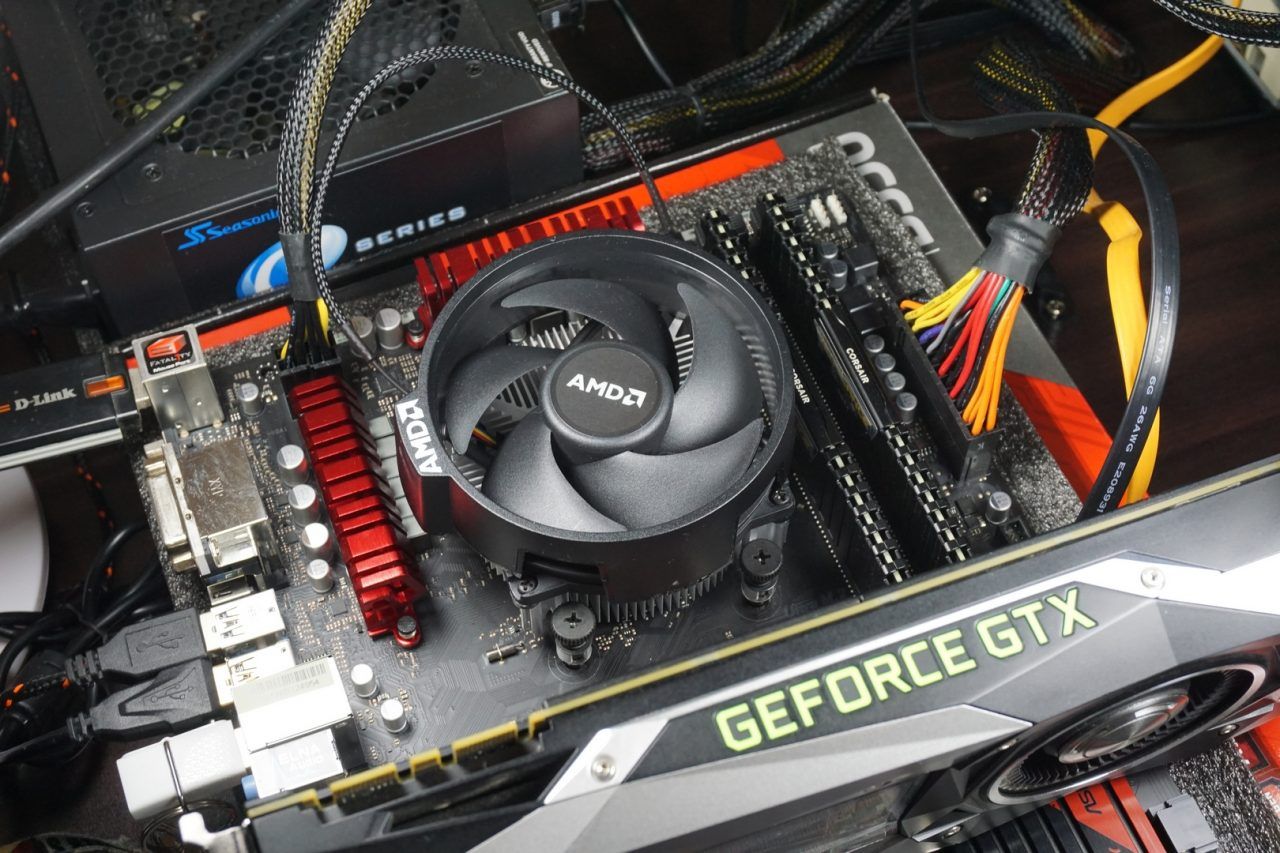
We used the following components to test AMD’s Ryzen 3 1300X:


As expected, we were able to push our Ryzen 3 1300X sample up to 4.0GHz at 1.35v without any hassle. That’s a 300MHz advantage over the stock Turbo of 3.7GHz. Much like most Ryzen processors, however, any further will result in a system crash no matter how high the voltages are.
System Benchmarks
Gaming Benchmarks
Conclusion

Despite its budget appeal, the Ryzen 3 1300X behaves like a Haswell-based i5. At 4-cores and 4-threads you won’t have much trouble in day-to-day use. You might find some headaches running heavier workloads such as editing high-resolution videos or rendering. The 1300X also performs decently in gaming, especially since most titles nowadays put a lot of stress to the GPU than the CPU. With that said, you still won’t reach the highest frame rates with the 1300X with games becoming more and more complex by the day. But for casual gaming or even eSports titles such as DotA 2, League of Legends, Counter Strike: Global Offensive, and Overwatch, the 4-core part from AMD will do just fine.
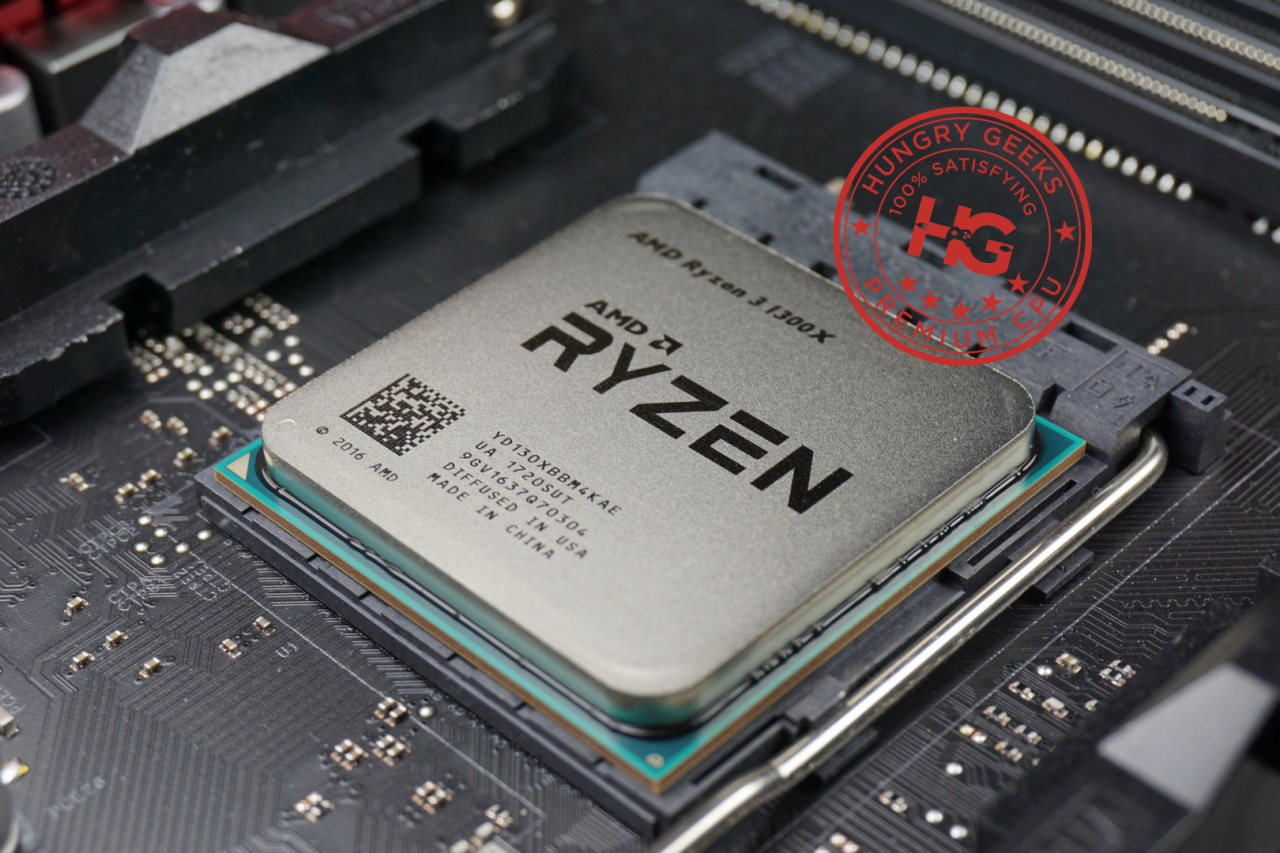
Like I have said in the past, Ryzen might have its faults like its lower performance in the single-core department compared to the Blue team, but its arrival ignites the competition in the long stagnating CPU market. All ranges from the market covered with Threadripper, Ryzen 7, Ryzen 5, and now Ryzen 3, customers can now choose between two camps for the next CPU instead of essentially just one. With its overall decent performance, you can’t go wrong with the AMD Ryzen 3 1300X, which is why we’re giving it our premium CPU award.
